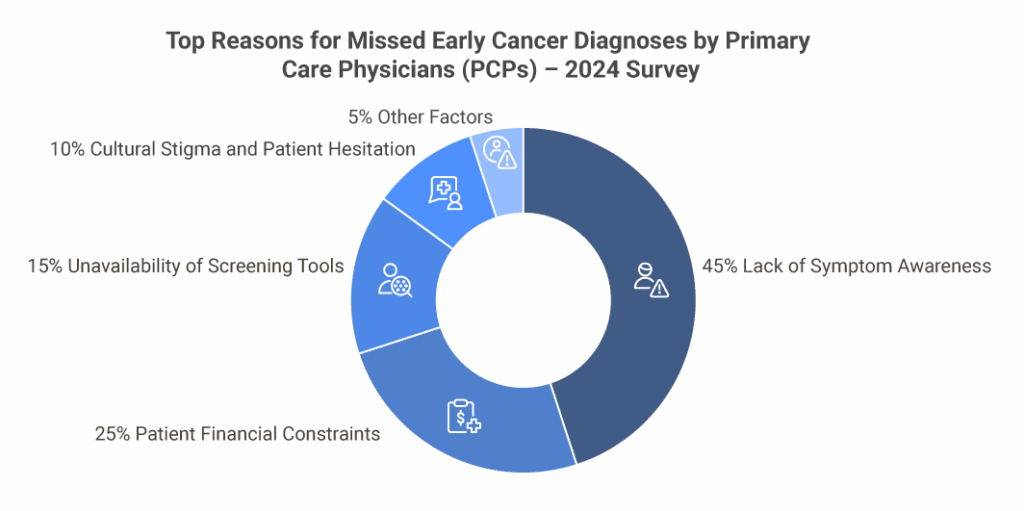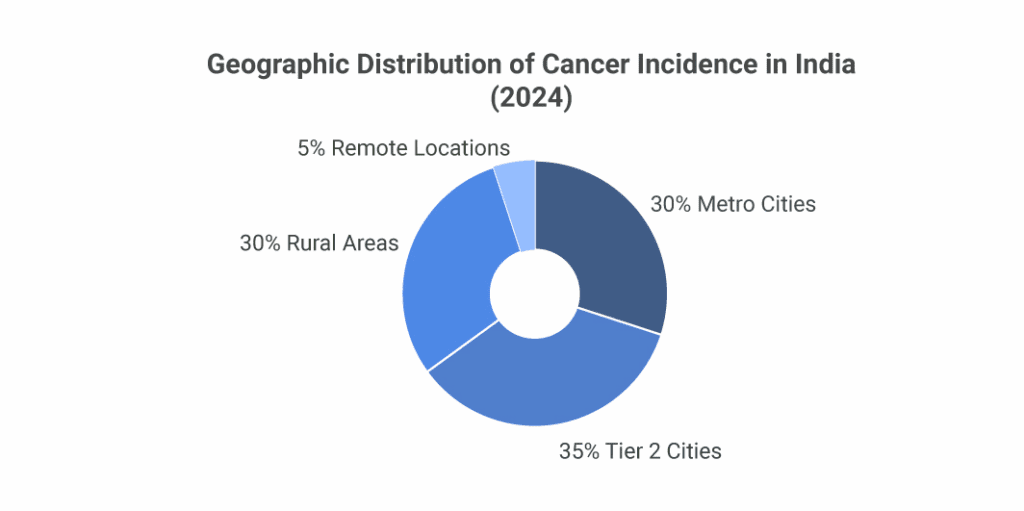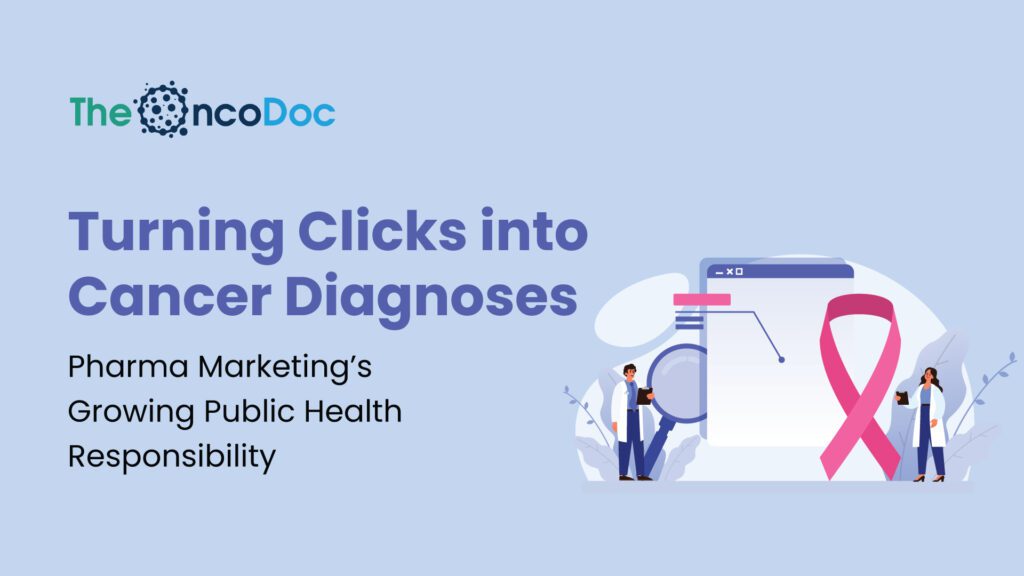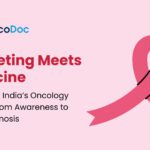Introduction: Expanding the Pharma Role Beyond Treatment
Pharmaceutical companies in the oncology sector have traditionally limited their marketing focus to oncologists and hospital decision-makers, primarily centering around post-diagnosis treatment promotion. However, India’s cancer care ecosystem presents an urgent need,and a significant opportunity, for pharma marketers to intervene much earlier in the patient journey: at the stage of awareness, screening, and early detection.
With cancer survival rates deeply tied to early diagnosis, and more than 65% of cancer patients in India being diagnosed at Stage III or IV, pharma brands can no longer afford to stay on the sidelines of public health education. Instead, they must embrace a broader role, actively engaging patients, caregivers, primary care physicians (PCPs), and health policymakers to promote timely diagnosis.
This article explores how pharma marketers in oncology can strategically design, deploy, and optimize digital campaigns that not only enhance early diagnosis rates but also improve health outcomes while boosting brand equity.
1. The Diagnosis Gap: A Public Health and Marketing Challenge
The epidemiological data surrounding cancer in India is stark:
- Estimated new cancer cases (2024): 1.5 million
- Cancer-related deaths (2024): 850,000
- Percentage diagnosed in late stages: 65-70%
A recent study by the Indian Council of Medical Research (ICMR) revealed that only 20-25% of Indian cancer patients receive a diagnosis in Stage I or II, drastically lowering survival probabilities compared to global benchmarks.
Source: Indian Council of Medical Research (ICMR), 2024.
The underdiagnosis in early stages is attributed to several factors:
- Low symptom awareness among the general public
- Limited cancer screening infrastructure in Tier 2 and Tier 3 cities
- Inadequate referral practices by general physicians
- Socio-cultural stigma surrounding cancer diagnosis
These statistics underline a critical question for pharma marketers:
Can oncology brands expand their marketing strategy to address this diagnosis gap, without compromising ethical standards?
2. The Evolution of Pharma Marketing Objectives: From Treatment-Centric to Continuum-of-Care Focus
Pharma marketing in oncology has historically revolved around product promotion to specialists. However, global trends now highlight a shift toward continuum-of-care engagement, which involves influencing patient outcomes across the following stages:
- Awareness and Risk Identification
- Screening and Early Detection
- Timely Referral and Diagnosis
- Treatment Initiation
- Survivorship and Follow-Up
This expanded marketing mindset demands that pharma brands invest in patient education campaigns, HCP engagement tools, screening partnerships, and digital behavior change communication (BCC) initiatives.
Oncology marketers now have a mandate not just to sell products, but to save lives through education and access facilitation.
3. Digital Channels: The Backbone of Modern Oncology Awareness Campaigns
Given India’s mobile-first internet ecosystem, digital platforms offer the most scalable and cost-effective way for pharma brands to deliver high-impact awareness campaigns.
Key Digital Channels and Tactics:
| Channel | Application Area |
| WhatsApp Business API | Symptom education for rural PCPs and patient families |
| YouTube and OTT Ads | Survivor stories, screening awareness videos |
| Google Search Ads | Intent-based symptom searches like “oral ulcer cancer” |
| Regional Social Media | Facebook and Instagram reels in local languages |
| Telemedicine Apps | CME modules, referral alerts for doctors |
| Programmatic Display Ads | Geo-targeted ads in high-incidence districts |
By leveraging these platforms, pharma marketers can ensure that both doctors and patients receive the right message, at the right time, in the right language.
4. Targeting Primary Care Physicians (PCPs): The First Line of Detection
A recent survey conducted by Medindia (2024) found that over 60% of cancer patients first present symptoms at non-specialist clinics, primarily with primary care doctors or general practitioners.
Effective Strategies to Empower PCPs:
- Symptom Recognition Playbooks
- Printable and digital guides on “Red Flag Symptoms” for cancers like breast, cervical, colorectal, and oral cancers.
- Referral Pathway Algorithms
- Simple decision trees that PCPs can follow to identify high-risk cases needing specialist referral.
- Interactive WhatsApp Bots
- Automated symptom-based triage tools with referral recommendations.
- Tele-CME Programs
- Short, mobile-friendly educational sessions delivered via platforms like Practo Learn, Hidoc Dr, and Docplexus.

5. Regional Targeting: Going Beyond Metros
Cancer incidence is rising in semi-urban and rural districts, but awareness remains low.

Source: Indian Council of Medical Research (ICMR), 2024.
Pharma marketers should:
- Geo-fence programmatic ads in high-burden districts.
- Partner with local NGOs and health departments for district-level awareness drives.
- Utilize regional influencers and community radio channels to disseminate educational content.
Case Study: Cervical Cancer Screening Campaign – Uttar Pradesh
Campaign Objective: Increase uptake of cervical cancer screening among women aged 30-50 in rural Uttar Pradesh.
Tactics Used:
- WhatsApp voice notes by female health workers on screening importance.
- Mobile vans equipped with VIA (Visual Inspection with Acetic Acid) tools, branded in collaboration with the pharma sponsor.
- Social media ads targeting mothers with health education content in Hindi.
Outcomes (3 months post-campaign):
- 40,000 women reached via digital channels.
- 8,500 screenings conducted.
- 120 early-stage cases detected.
This example demonstrates how pharma marketers can blend digital reach with on-ground action for measurable public health impact.
6. Survivor-Led Influencer Campaigns: Humanizing the Message
Pharma brands can build trust by collaborating with cancer survivors as digital ambassadors.
Campaign Ideas:
- Instagram Live Q&A sessions with survivors discussing symptom journeys.
- Facebook Story Takeovers by survivors during awareness weeks (e.g., Breast Cancer Awareness Month).
- YouTube mini-documentaries sponsored by pharma brands but centered on patient voices.
These campaigns shift the narrative from brand-centric to patient-centric communication, improving engagement and credibility.
7. Multilingual Content: Bridging Linguistic Gaps in Oncology Awareness
India’s vast linguistic diversity presents both a challenge and an opportunity for pharma marketers aiming to drive early cancer diagnosis. With over 22 official languages and hundreds of dialects, delivering oncology awareness campaigns in multiple languages is no longer optional, it’s essential for reach and impact.
To ensure effective communication across diverse populations, pharma brands must adopt a multilingual content strategy tailored to regional preferences. This involves using localized keywords for Google search campaigns to improve visibility among vernacular audiences. For video platforms like YouTube, deploying vernacular voice-over artists helps make educational content more relatable and credible.
Additionally, distributing infographics, symptom checklists, and e-books in local scripts enhances comprehension and engagement, especially in Tier 2 and rural markets. Collaborating with regional health bloggers, local influencers, and community health organizations further amplifies reach, lending cultural authenticity to the messaging.
Such multilingual campaigns not only increase public awareness but also address socio-cultural barriers that often delay cancer diagnosis. By delivering medically accurate, emotionally resonant content in native languages, pharma marketers can ensure that life-saving cancer education transcends linguistic boundaries and reaches all socio-economic segments effectively.
8. Data Analytics: Measuring Campaign Effectiveness and Behavior Change
Digital oncology campaigns must be data-driven and performance-optimized.
Metrics to Track:
| Metric | Significance |
| Click-Through Rate (CTR) | Engagement with digital ads |
| Referral Form Downloads | Doctor engagement and follow-up intent |
| Screening Center Appointments | Conversion of public awareness into action |
| Heat Maps of High-Engagement Zones | Regional effectiveness of geo-targeted campaigns |
| Social Sharing Rates | Virality and message amplification |
By combining Google Analytics, CRM tools, and WhatsApp engagement dashboards, pharma marketers can constantly refine their strategy.
9. Policy Advocacy: Partnering with Government Health Programs
No early detection campaign can scale sustainably without alignment with public health policies.
Pharma marketers must engage with:
- National Health Mission (NHM)
- Ayushman Bharat Digital Mission
- State Cancer Control Programs
Through PPP (Public-Private Partnership) models, pharma brands can:
- Fund mobile screening units.
· Encourage ASHA employees to receive cancer symptom training
- Provide digital infrastructure for referral tracking.
Examples of successful pharma-government collaborations include breast cancer screening drives in Tamil Nadu and tobacco cessation programs in Bihar.
10. Ethical Considerations in Pharma-Led Public Health Campaigns
While driving early diagnosis campaigns, pharma marketers must:
- Maintain scientific neutrality in educational content.
- Avoid overt brand promotion in patient-facing materials.
3. In accordance with India’s Digital Personal Data Protection Act, or DPDP 2023, respect patient data privacy standards.
- Collaborate with oncologists, epidemiologists, and health authorities during campaign design.
The focus should remain on health outcome improvement first, brand-building second.
11. Integrating Offline and Online Touchpoints
Successful campaigns don’t operate in isolation.
Omni-Channel Journey Suggestion:
- Step 1: Send a WhatsApp message about cancer symptoms that is geotargeted.
- Step 2: FM radio public service announcement.
- Step 3: Digital ad retargeting on social media.
- Step 4: On-ground health camp in the targeted area.
- Step 5: Reminder via WhatsApp or follow-up SMS for screening.
By building sequential and multi-touchpoint campaigns, pharma marketers can drive behavioral change at scale.
12. Preparing for the Future: Digital Innovations on the Horizon
Emerging digital tools like conversational AI, virtual patient navigators, AR/VR-based doctor training, and hyperlocal predictive modeling will further enhance the ability of oncology marketers to impact early diagnosis rates.
Pharma marketers should prepare to integrate:
- Chatbots in regional languages
- AI-powered HCP targeting based on referral behavior
- Behavioral segmentation of patient audiences using RWE (Real-World Evidence)
Precision public health marketing is the next frontier, where efforts are intelligently tailored rather than just mass-blasted.
Conclusion: Pharma Marketing with Purpose: Driving Early Action for Better Oncology Outcomes
India’s oncology landscape is at a pivotal juncture, where the growing cancer burden demands more than just treatment-focused pharmaceutical marketing. With late-stage diagnosis rates alarmingly high, it is evident that traditional reactive marketing approaches no longer serve the larger goal of improving patient outcomes. Pharma marketers must now embrace a strategic shift, from product promotion after diagnosis to proactive engagement that facilitates early detection and timely intervention.
This transformation in marketing philosophy offers pharma brands the opportunity to contribute meaningfully to public health while driving sustainable business outcomes. Those companies that choose to lead this change will experience multiple long-term benefits:
- Improved Public Health Outcomes: By designing campaigns that educate both healthcare professionals and the general public about early cancer symptoms and screening protocols, pharma brands can help reduce late-stage diagnoses and improve survival rates.
- Stronger Doctor Engagement: Physicians, especially in primary care settings, will view pharma companies not just as drug suppliers but as partners in improving patient care pathways.
- Enhanced Corporate Reputation: Purpose-driven campaigns centered on health outcomes rather than mere product promotion can enhance trust and brand equity among stakeholders, including patients, healthcare providers, and policymakers.
- Sustainable Business Growth: By aligning marketing strategies with broader healthcare priorities, pharma brands can foster long-term loyalty among HCPs and health institutions, ensuring market relevance even in an evolving regulatory landscape.
In a country like India, where every day’s delay in cancer diagnosis could mean the difference between life and death, pharma marketers can no longer afford passive engagement or narrowly focused campaigns. The time has come to market with purpose, act with empathy, and communicate with scientific responsibility.
By recognizing early detection as the next frontier in oncology marketing, pharma companies can position themselves not only as commercial leaders but also as key enablers of systemic healthcare improvement. The future of pharma marketing in oncology lies in driving awareness, facilitating early action, and ultimately saving more lives, a goal where both business success and social impact go hand in hand.
The Oncodoc team is a group of passionate healthcare and marketing professionals dedicated to delivering accurate, engaging, and impactful content. With expertise across medical research, digital strategy, and clinical communication, the team focuses on empowering healthcare professionals and patients alike. Through evidence-based insights and innovative storytelling, Hidoc aims to bridge the gap between medicine and digital engagement, promoting wellness and informed decision-making.



